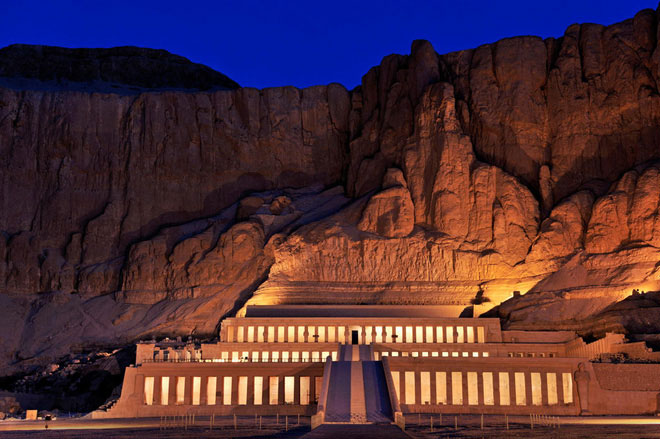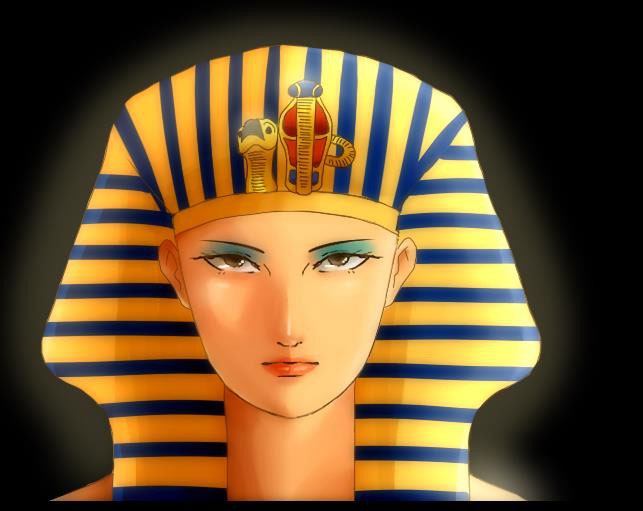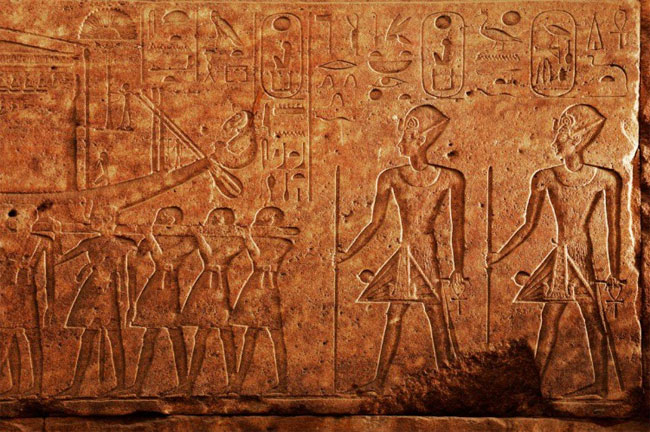The mausoleum of the beautiful Queen of Egypt despite the destruction of her stepmother
Hatshepsut Tomb in Egypt possesses an excellent architecture. But the most surprising thing was that the female master was resting inside.
The tomb of the Egyptian Queen Hatshepsut is located in the complex of moving Deir el Bahri on the west bank of the Nile. The face of the tomb is opposite the city of Luxor, his back leaning against the hard cliffs and upright challenging in the desert.

Hatshepsut's tomb is beautiful under the sunset.
The tomb was ordered by the Queen herself when she was alive, and was a work ahead of her time. Today, looking outside the mausoleum, everyone can't help but suppress the absolute harmony of the pillars. The greater is that it was built nearly 1,000 years ago the Parthenon temple - the pride of the Greeks with similar architecture.
Queen Hatshepsut was the eldest daughter of King Thutmose I. She was the queen of the 18th dynasty, until her husband was her brother - King Thutmose II died.
At that time, although her husband's son, Thutmose III, was of sufficient age, the queen still had to assume the responsibilities of the nation.
After that, Hatshepsut abandoned the young king, officially becoming one, reigning for more than 20 years.

The queen is also said to have an enchanting beauty.

The inscription inside the mausoleum: 2 people who are nearly identical express "a two-pharaoh country", with the Queen standing up first (later she abandoned the king).
Today, relics show that the power of Queen Hatshepsut is still preserved. In the ancient city of Thebes, she had ordered the removal of monuments to take place for the development of the road, taking the cause of the name of god Amun - the supreme deity and patron of the pharaohs.
In the early days of his rule, Hatshepsut also fought, securing many areas from Nubia in the east to Beni Hasan in Egypt today.
However, more than 20 years of reign of the queen was almost tied to the prevailing peace. She resolved the backlog of the past - when Egypt was occupied by the Hyksos (a multi-origin nation, mostly from West Asia) that caused trade to be interrupted. Later, thanks to Hatshepsut, trade relations were connected.

The inscription inside the tomb: the sailor is carrying the aromatic plant into the port under the Queen's command.
In ancient times, the Queen also had the foresight when she explored waterways to the Punt (ancient land where it is still unknown). There were more than 200 sailors on the road, carrying scented plastic, crossing the Red Sea to Punt and bringing the incense tree to live with many precious produce.
The prosperity of the dynasty also allowed Hatshepsut to conduct great architectural projects, such as the Queen's tomb or memorial tower. Hatshepsut memorial tower is carved out of a single granite block, 30 meters taller and also the tallest tower of ancient Egypt, towering to this day.

Hatshepsut memorial tower.

Pharaoh statue and the Sphinx of the Queen.In the left statue, she is carved like a man, except for the pointed chin and round breasts.
The statue of Queen Hatshepsut is also present everywhere, even carved under the male figure with the head Khat hat - the symbol of power.
Unfortunately, the Queen's legacy has fallen into oblivion for thousands of years. When she died in 1458 BC, King Thutmose III tried to erase all the marks of "stepmother". He smashed the statue, smeared the painting, tried to ruin the Queen's memorial tower.

Mummies of servants (left) and of the Queen of Egypt.
Some say it is a betrayal, some believe it is a forced situation, clearing the king's way.
Another theory is that the king wanted a seamless connection between three Thutmose kings, I, II, and III. Therefore, it is necessary to erase the traces of Queen Hatshepsut who has been storming for 20 years.
Anyway, during 1923-1931, Egyptian archaeologists found and restored buried vestiges, uncovering evidence of the Queen's power. Today, these relics are located in front and inside the tomb.
The famous Egyptologist Donald Redford went against the crowd. He said, "Here and there, the oval shape and the image of the queen still remain intact - something that the ordinary eye will never see, still gives the king warmth and devotion to divine presence ".

The engraved toothbox called Hatshepsut - coincides with a missing tooth on the mummy, uncovering the mystery of a forgotten Queen.
- The reason Nefertiti is considered the most beautiful queen in Egypt
- Real story of the Egyptian queen Cleopatra
- Lost legs of the 3,000-year-old Egyptian queen
- Controversy over the grave of the eminent Queen of Egypt
- The tomb of the Queen of Egypt may reveal many secrets
- Treasure and pearls 3,000 billion in Xu Hy's mouth
- The most beautiful, bohemian queen of France
- Looking for the most tragic queen's tomb in Egypt: Must marry her grandfather, father and brother
- Makeup like Queen Cleopatra is good for the eyes
- Discover new beauty of Egyptian queen Nefertiti
- The restored face of the Queen of Egypt is controversial
- Few knew before Egypt's most famous Pharaoh Tut had two female Pharaohs reigning for a while
 Discovered an ancient centipede fossil 99 million years old
Discovered an ancient centipede fossil 99 million years old Discovered bat-like dinosaurs in China
Discovered bat-like dinosaurs in China Discovered a 200-year-old bronze cannon of the coast
Discovered a 200-year-old bronze cannon of the coast Discover 305 million-year-old spider fossils
Discover 305 million-year-old spider fossils